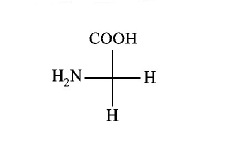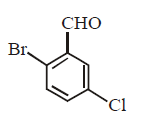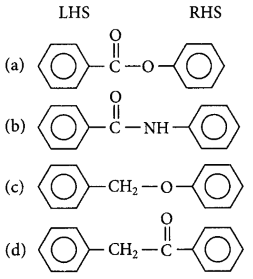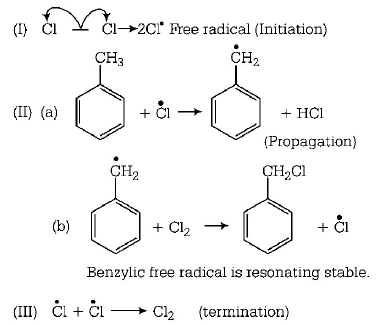161. Which of the following will not give a white ppt. when $$AgN{O_3}$$ is added to its solution?
A
$$CC{l_4}$$
B
$$NaCl$$
C
$$MgC{l_2}$$
D
$$KCl$$
Answer :
$$CC{l_4}$$
162. Which of the following molecules is expected to rotate the plane of plane - polarised light ?
A


B


C


D


Answer :


163.
Which of the following is the $$IUPAC$$ name of the compound

A
$$o$$ – Bromo – $$m$$ – chlorobenzaldehyde
B
$$2$$ – Bromo – $$5$$ – chlorobenzaldehyde
C
$$6$$ – Bromo – $$3$$ – chlorobenzaldehyde
D
$$1$$ – Bromo – $$4$$ – chlorobenzaldehyde
Answer :
$$2$$ – Bromo – $$5$$ – chlorobenzaldehyde
164.
In which of the following compounds electrophilic aromatic substitution takes place in phenyl ring present in left hand side $$(LHS)?$$

A
(a)
B
(b)
C
(c)
D
(d)
Answer :
(d)
165. Which one of the following is a free radical substitution reaction ?
A


B


C


D


Answer :


166. The $$(R)$$ - and $$(S)$$ - enantiomers of an optically active compound differ in
A
their solubility in a chiral solvent
B
their reactivity with a chiral reagent
C
their optical rotation of plane polarised light
D
their melting points
Answer :
their optical rotation of plane polarised light
167. In Lassaigne's test for $$N, S$$ and halogens, the organic compound is
A
fused with sodium
B
dissolved with sodamide
C
extracted with sodamide
D
fused with calcium
Answer :
fused with sodium
168.
The correct IUPAC name of the following compound is : 
A
5 - chloro - 4 - methyl - 1 - nitrobenzene
B
2 - chloro - 1 - methyl - 4 - nitrobenzene
C
3 - chloro - 4 - methyl - 1 - nitrobenzene
D
2 - methyl - 5 - nitro - 1 - chlorobenzene
Answer :
2 - chloro - 1 - methyl - 4 - nitrobenzene
169. Which of the following compounds will exhibit $$cis-trans$$ (geometrical) isomerism?
A
2-butene
B
Butanol
C
2-butyne
D
2-butenol
Answer :
2-butene
170. Which of the following orders correctly depicts the decreasing order of stability of carbanion?
A


B


C


D


Answer :





